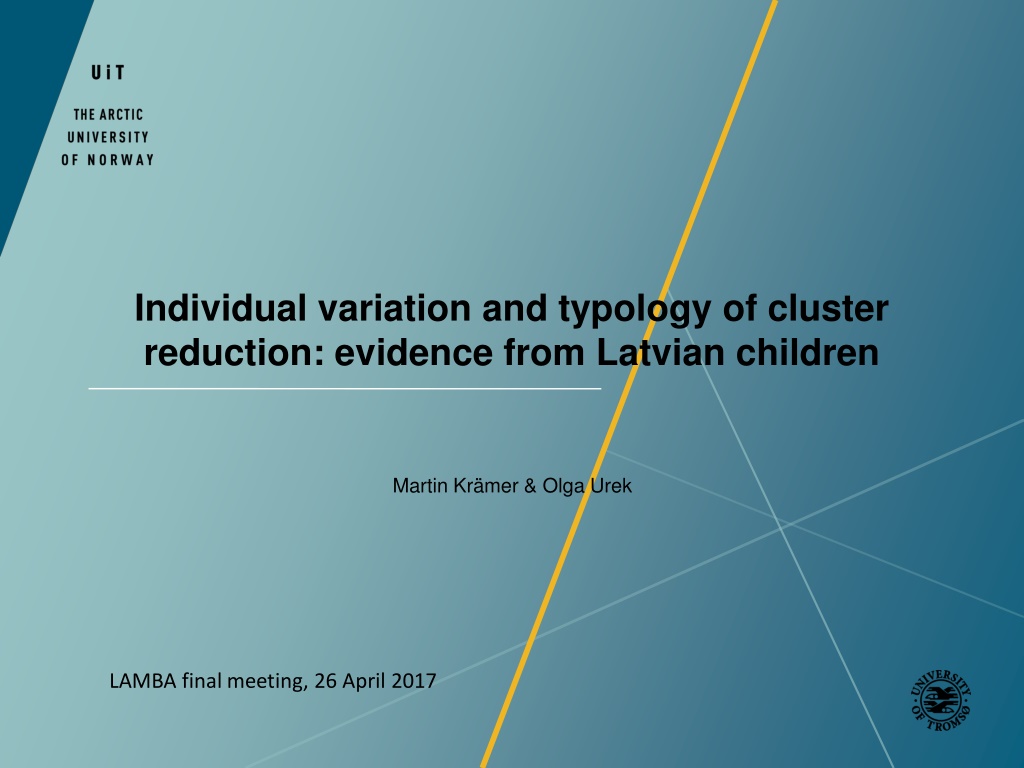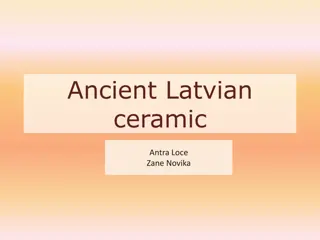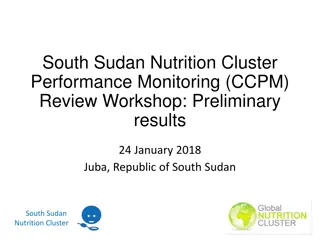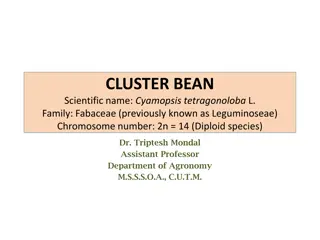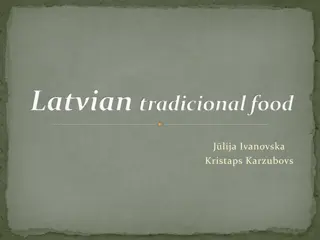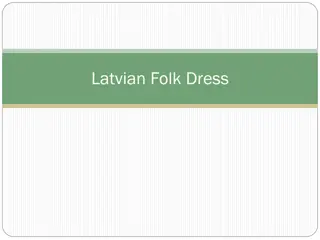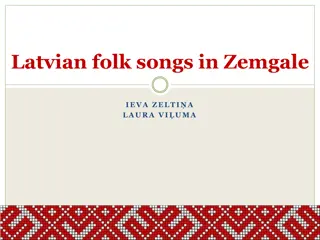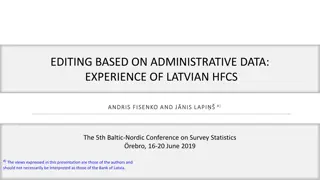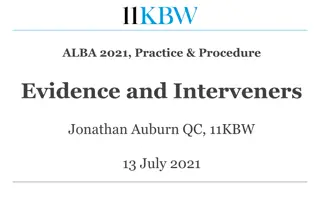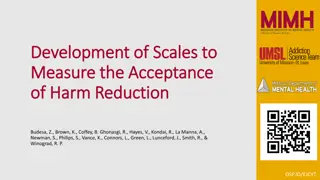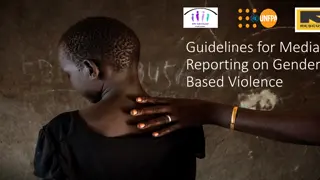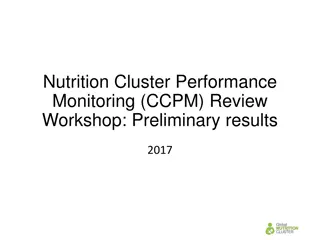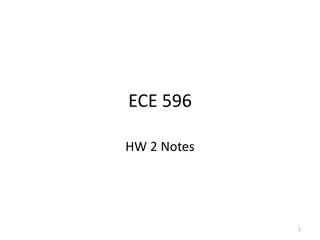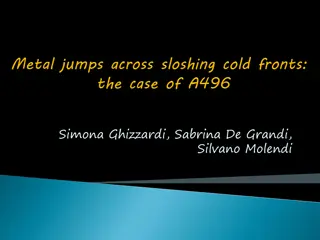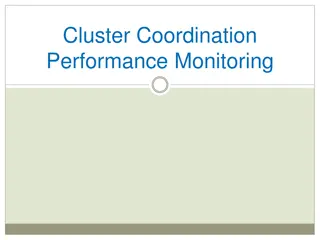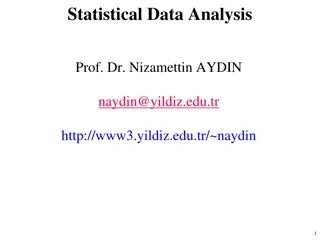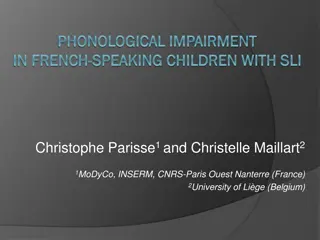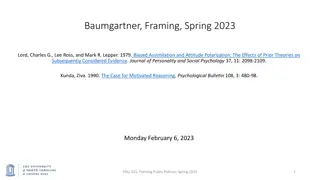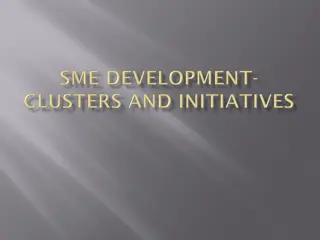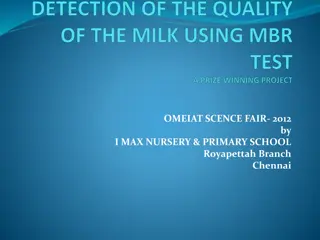Evidence of Cluster Reduction in Latvian Children
Investigation explores errors in L1 acquisition of complex word-initial onsets in Latvian children, examining the role of sonority, constraints on complex onsets, and factorial typology of OT constraints. Data from the LAMBA phoneme test with 20 Latvian-speaking children highlights various cluster types and coding for production accuracy. The study sheds light on factors influencing cluster reduction and production patterns in Latvian-speaking children.
Download Presentation

Please find below an Image/Link to download the presentation.
The content on the website is provided AS IS for your information and personal use only. It may not be sold, licensed, or shared on other websites without obtaining consent from the author. Download presentation by click this link. If you encounter any issues during the download, it is possible that the publisher has removed the file from their server.
E N D
Presentation Transcript
Individual variation and typology of cluster reduction: evidence from Latvian children Martin Kr mer & Olga Urek LAMBA final meeting, 26 April 2017
Introduction Which errors do children make in the L1 acquisition of complex word-initial onsets in Latvian? Which role does sonority play in the acquisition of complex onsets? Do established constraints and principles on complex onsets account for the data? Does constraint reranking suffice to account for the attested variation? Does the factorial typology of OT constraints provide a 100% match of attested patterns? If it doesn t, how do we fix this? Which other factors play a role? Perceptual biases, articulatory challenges? Data from the LAMBA phoneme test Picture naming task with children
Participants 20 monolingual Latvian-speaking children (mean age = 47 months, SD = 9.3); Recruited in kindergartens in Riga, with Latvian as the only language of instruction; Part of a larger study: norming study for Latvian Phoneme Test (LAMBA); 500 monolingual Latvian-speaking children total (36-72 months); 20 children obtaining the lowest scores were selected;
Procedure Latvian Phoneme Test: 91 pictures depicting objects and actions; items chosen to contain all consonants and selected clusters in initial, medial and final position Children tested individually in a quiet room by two evaluators; Picture-naming procedure: Ev. 1 showed the pictures to the child; Ev. 2 marked the responses on the scoring sheet; Each session was audio-recorded and later transcribed; Spontaneous production was elicited where possible; If the child could not name the picture spontaneously, delayed imitation was used;
Data set: scope All attempts at word-initial two-member clusters were extracted; Six cluster types were considered: stop + lateral (e.g. [bl-]) 3 items stop + rhotic (e.g. [tr-]) 6 items stop + nasal (e.g. [kn-]) 1 item s + lateral (e.g. [sl-]) 2 items s + nasal (e.g. [sn-]) 2 items s + stop (e.g. [st-]) 5 items NB: s + rhotic clusters are illicit in Latvian Note: number of items per cluster type varies due to the structure of the Phoneme Test.
Data set: coding Child responses were coded to reflect the production of the attempted cluster: fully correct: /sluota/ [sluota] broom fully omitted: /gredzens/ [edents] ring retained with segmental changes: /kru:ze/ [klu:ze] cup reduced to the less sonorous element: /blu:ze/ [bu:de] blouse reduced to the more sonorous element: /snieks/ [nieks] snow A profile was generated for each child showing their production patterns for each cluster type:
Data set: dealing with intra-speaker variation Young children often demonstrate variable productions: i.e. not all inputs of the same type are consistently treated in the same way (e.g. Smith 1973, 2010) Such variability is to be expected, since acquisition occurs gradually (Becker & Tessier 2010). In addition, both precocious and fossilized forms i.e. individual memorized words that do not reflect the current state of a child s phonology can contribute (Tessier 2009)
Data set: dealing with intra-speaker variation OT literature: intra-speaker variation in children and adults is the result of partial constraint ranking (Becker & Tessier 2010, Anttila 1997), i.e. the situation where dominance relation between two or more constraints is not fixed. In such cases, unranked constraints can assume any mutual ranking each time a speaker attempts some production, which leads to variable results: Attempt A: Cluster reduction Attempt B: No reduction
Data set: dealing with intra-speaker variation In children, partial ranking is eventually resolved based on the positive evidence from the ambient language. Crucially, the process is gradual: the proportion of non-target-like productions decreases slowly over time, and variability dies out (see Becker & Tessier 2010 for technical implementation in OT). THEREFORE: For children showing variation in their treatment of a given input: if one of the patterns is preferred, we assumed it best reflects the state of child s grammar, and disregarded the other one; if no pattern is preferred, we assumed the existence of two grammar- states, and both were included into the analysis. children who varied on more than one cluster type (N=2) were excluded.
Data set Thus, 18 children gave us the total of 27 observations or 12 patterns. Pattern A Pattern B Of these, 9 followed Pattern A, 6 followed Pattern B, and the remaining 12 were unique. Bad news: acquisition paths vary a lot more than theoretical literature would have you believe. Good news: more than half of the data is accounted for by just 2 patterns. Definitely not random!
Distribution of Reduction Patterns by Cluster Type
The full typology SL SN ST TN TL GA S N T T T GB S S T T T GC SL S T T T GD SL N T T TL GE L N T T TL GF SL2 SN ST T T GG S SN ST T T GH S N T N T GI L N T N TL GJ SL N T N T GK S S S T T GL T SN T T T
Building the typology To do a typology with OT Workplace, we abstract away from segmental changes. Sometimes L and R fluctuate. Sometimes only TL is present but not TR. Sometimes /pl/ is realized as [t], apparently coalescence rather than deletion. We count this nevertheless as reduction to least sonorant aka deletion of L. We consider only deletion as an option. (No kid epenthesises vowels to break up consonant clusters anyway.) Inputs: /SL, SN, ST, TL, TN/ Input-output mappings /SL/ SL, S, L, S-L (hyphen = S in appendix) /SN/ SN, S, N, S-N /ST/ ST, S, T, S-T /TL/ TL, T, L /TN/ TN, T, N
The typology Colour legend: Green = targetlike Light green = attested lg. Yellow: Attested in our data That other colour: Phonetically the same as one of our patterns
Fewer problem zones in the attested typology SL SN ST TL TN GA S N T T T GB S S T T T GC SL S T T T GD SL N T TL T GE L N T TL T GF SL SN ST T T GG S SN ST T T GH S N T T N GI L N T TL N GJ SL N T T N GK S S S T T GL T SN T T T
Fixing remaining problems or what else do the Latvian kids teach us about syllable phonotactics? 4 Grammars undergenerated and 17 grammars overgenerated. Overgeneration is not such a big deal: We had only 20 children. Resilience of N to deletion in TN /kn/ 1: Perception interferes with grammar. Nasality cues mask stop release and stop s place cues, children don t perceive k. Resilience of N to deletion in TN /kn/ 2: Articulation interferes with grammar. Timing of stop gestures and velum lowering difficult to coordinate. Resilience of N to deletion in TN /kn/ 3: Possibly coalescence, as in /pl/ -> [t], N is stop anyway. Resilience of N to deletion in TN /kn/ 4: N is stop anyway. Misanalysed as low sonority nasal (Kr mer & Zec 2016) GI: (L, N, T, TL, N) = 2ndC wins. We could add CONTIGUITY to Con. Overgenerates *(L, N, S, N, L) GL: (T, SN, T, T, T) We still wonder what that child is doing here.
Conclusions The 20 weakest Latvian children produce patterns that ...are not all attested in phonotactic typology ...are not all generated by standard syllable theory. Assuming stratal organisation of grammar and syllabification in the input to the last level matches results better, but overgenerates even more. Though, we haven t looked at complex onset tpyology in detail yet. The remaining three child patterns can be explained by various grammatical and extragrammatical assumptions Word of caution: We are looking at the worst out of 500. We re potentially dealing with phonological pathologies, e.g., SLI.
